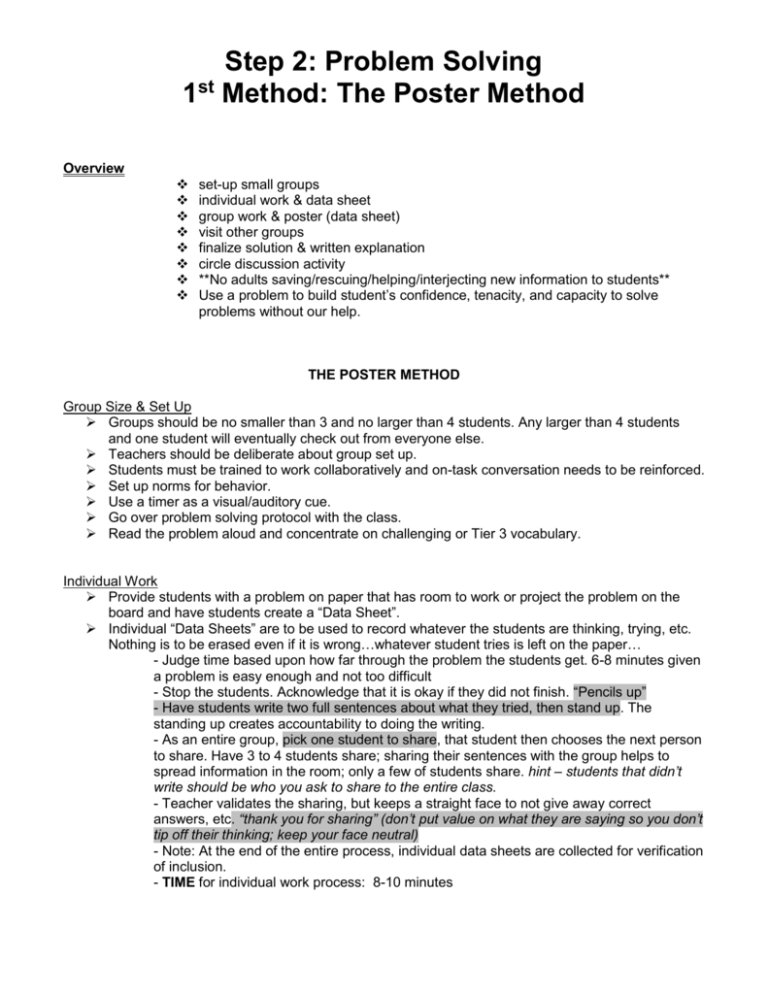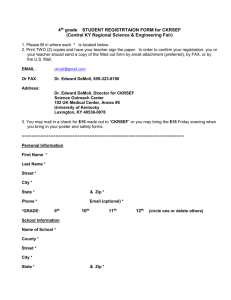the poster method
advertisement

Step 2: Problem Solving 1st Method: The Poster Method Overview set-up small groups individual work & data sheet group work & poster (data sheet) visit other groups finalize solution & written explanation circle discussion activity **No adults saving/rescuing/helping/interjecting new information to students** Use a problem to build student’s confidence, tenacity, and capacity to solve problems without our help. THE POSTER METHOD Group Size & Set Up Groups should be no smaller than 3 and no larger than 4 students. Any larger than 4 students and one student will eventually check out from everyone else. Teachers should be deliberate about group set up. Students must be trained to work collaboratively and on-task conversation needs to be reinforced. Set up norms for behavior. Use a timer as a visual/auditory cue. Go over problem solving protocol with the class. Read the problem aloud and concentrate on challenging or Tier 3 vocabulary. Individual Work Provide students with a problem on paper that has room to work or project the problem on the board and have students create a “Data Sheet”. Individual “Data Sheets” are to be used to record whatever the students are thinking, trying, etc. Nothing is to be erased even if it is wrong…whatever student tries is left on the paper… - Judge time based upon how far through the problem the students get. 6-8 minutes given a problem is easy enough and not too difficult - Stop the students. Acknowledge that it is okay if they did not finish. “Pencils up” - Have students write two full sentences about what they tried, then stand up. The standing up creates accountability to doing the writing. - As an entire group, pick one student to share, that student then chooses the next person to share. Have 3 to 4 students share; sharing their sentences with the group helps to spread information in the room; only a few of students share. hint – students that didn’t write should be who you ask to share to the entire class. - Teacher validates the sharing, but keeps a straight face to not give away correct answers, etc. “thank you for sharing” (don’t put value on what they are saying so you don’t tip off their thinking; keep your face neutral) - Note: At the end of the entire process, individual data sheets are collected for verification of inclusion. - TIME for individual work process: 8-10 minutes Group Work Work with your group and agree with your group on a solution. (work & answer) - Discuss each group member’s process and continue working before agreeing on a solution - Create a group data sheet (POSTER). It must represent ALL ideas in the group. May want to provide different color markers to help organize work. (Ask…”Can you show me where each of your ideas is represented?”) - All group member’s names need to be written on the poster. - TIME limit: 10 minutes (ideal) to 15 minutes (extreme max). - May want to supply visual to provide students with an organized way to display information. - Hints – label the board with “Hints” for students to write hints on the board. Title and Group names Individual student work in each box and then combined work in another box. Final solution Visit time (spying or reconnaissance) - One person stays with their group data sheet to explain what their group has done. Be sure to keep a person there that KNOWS how to explain - The other group members get to visit other tables to see what they have done and receive explanation from the other groups. The goal is for the students to gather more information. - TIME Limit: 3 minutes Finalize group solution - On the front of the paper at the bottom. (preferably a different color or denoted in another way) - Students can change their final solution if they like what they saw better than their own solution, whether it is a good decision or not. Groups need to show the changed answer with work and be able to explain the new process. - TIME limit: 5 minutes On BACK of poster: Write WRITTEN EXPLANATION at the top backside. Answer questions in complete sentences. - Train/teach students what you expect their responses to look like and contain. - “How did your group solve the problem?” - “How does your group know your solution is correct mathematically?” - “What do I know mathematically that supports WHY a formula works if you came up with one?” - Suggestion: Answer questions on back side in pencil or pen so it doesn’t show through. - When first doing Step 2, have students prepare and practice what they are going to say in the circle. This provides support and helps the circle discussion go more smoothly. -Let them know that any student can be accountable for the poster and sharing the groups thinking. (Hint: This is why it is important for them to write the responses to the questions on the back of the poster.) - TIME limit: 5 minutes Circle Discussion - Students stand in a circle shoulder to shoulder with their group; provide “rules” for how to behave in circle; hold paper still, one person talks at a time, everyone stands, no leaning/sitting, let students know that they will be in this circle with these requirements for only 10 minutes. - Everybody quietly observes the other posters: for about 30 seconds - Any student can be accountable for their poster and sharing their thinking. (Hint: Answers are on the back of the poster.) - Start by having each group share their final answer (number only); “Each group state your final answer” - ASK: “Which group feels strongly about their answer and is willing to explain why their answer is correct?” Students ask questions of each other to clarify. - ASK: “Who agrees or disagrees and why” (keep instructor out of it…facial expressions and all) - The circle is important because all students obtain the summary from different groups and it requires all students to be engaged in the process. - The circle promotes mathematical conversation about the math - If the correct answer does not come out of the circle discussion the teacher should go over the problem as a class that day or the next day to explain where things went wrong. - Show students how close they were to the answer to build their confidence. - TIME Limit: 10 minutes Final hand-in: Students hand in their individual data sheet for accountability purposes; some place it in the daily work category as a participation mark. Posters are turned in to instructors, but are NOT graded.







